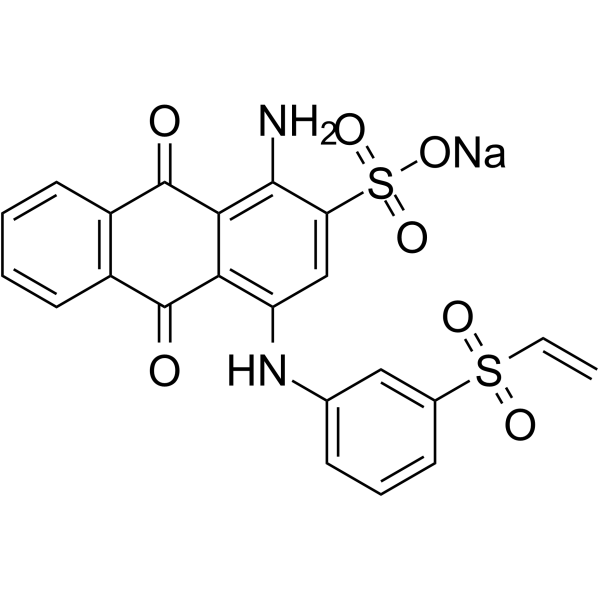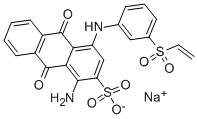单蓝A钠盐 ,sodium 1-amino-9,10-dihydro-9,10-dioxo-4-[m-(vinylsulphonyl)anilino]anthracene-2-sulphonate
产品编号:Bellancom-B273722| CAS NO:14541-90-3| 分子式:C22H15N2O7S2| 分子量:483.4942
Uniblue A钠是一种反应性蛋白质染色剂,可用于蛋白质的共价凝胶前染色(Ex=594 nM)。
本网站销售的所有产品仅用于工业应用或者科学研究等非医疗目的,不可用于人类或动物的临床诊断或者治疗,非药用,非食用,
| 产品名称 | 单蓝A钠盐 |
|---|---|
| 英文名称 | sodium 1-amino-9,10-dihydro-9,10-dioxo-4-[m-(vinylsulphonyl)anilino]anthracene-2-sulphonate |
| CAS编号 | 14541-90-3 |
| 产品描述 | Uniblue A钠是一种反应性蛋白质染色剂,可用于蛋白质的共价凝胶前染色(Ex=594 nM)。 |
| 产品熔点 | >300ºC(lit.) |
| 精确质量 | 506.02200 |
| PSA | 180.29000 |
| LogP | 5.42490 |
| 体外研究 | 指南(以下是我们推荐的方案。该方案仅提供指南,应根据您的具体需要进行修改)。1.制备衍生缓冲液:100 mM NaHCO3,10%十二烷基硫酸钠,pH 8-9.2.向90µL蛋白质溶液中加入10µL 200 mM Uniblue A溶液(溶解于衍生缓冲液中)。3.将样品在100°C下加热1分钟,以进行染色。4.在pH 6.8的200 mM Tris缓冲液中加入100µL由10%甘油和20 mM二硫代维甲酸(DTT)组成的还原溶液。5.过量的Uniblue A与Tris反应,生成蓝色化合物,作为电泳的流动前沿指示剂。6.样品在100°C下再加热一分钟,以实现有效还原,并冷却至室温。7.加入含有550 mM碘乙酰胺(IAA)的20µL烷基化溶液,孵育5分钟。8.对样品进行SDS-PAGE分析。注:干蛋白质样品或相容缓冲液中的样品(即无胺)可直接用衍生缓冲液稀释至5 mg/mL。在其他情况下,建议事先通过超滤进行三氯乙酸(TCA)/丙酮沉淀或缓冲液交换(见下文)。作为阳性对照,衍生缓冲液中的牛血清白蛋白(BSA)浓度为10 mg/mL。 |
| 稳定性 | 遵照规定使用和储存则不会分解。 |
| 储存条件 | 密闭于阴凉干燥环境中 |
相关文档
化学品安全说明书(MSDS)
下载MSDS质检证书(COA)
相关产品
| 符号 |

GHS07 |
|---|---|
| 信号词 | Warning |
| 危害声明 | H302 |
| 个人防护装备 | dust mask type N95 (US);Eyeshields;Gloves |
| 危害码 (欧洲) | Xn: Harmful; |
| 风险声明 (欧洲) | R22 |
| 危险品运输编码 | NONH for all modes of transport |
Synonym:None Known Section 2 - COMPOSITION, INFORMATION ON INGREDIENTS
Risk Phrases: None Listed. Section 3 - HAZARDS IDENTIFICATION EMERGENCY OVERVIEW
The toxicological properties of this material have not been fully investigated. Potential Health Effects Eye: May cause eye irritation. Skin: May cause skin irritation. Ingestion: May cause irritation of the digestive tract. The toxicological properties of this substance have not been fully investigated. Inhalation: May cause respiratory tract irritation. The toxicological properties of this substance have not been fully investigated. Chronic: No information found. Section 4 - FIRST AID MEASURES Eyes: Flush eyes with plenty of water for at least 15 minutes, occasionally lifting the upper and lower eyelids. Get medical aid. Skin: Get medical aid. Flush skin with plenty of water for at least 15 minutes while removing contaminated clothing and shoes. Wash clothing before reuse. Ingestion: Never give anything by mouth to an unconscious person. Get medical aid. Do NOT induce vomiting. If conscious and alert, rinse mouth and drink 2-4 cupfuls of milk or water. Inhalation: Remove from exposure and move to fresh air immediately. If not breathing, give artificial respiration. If breathing is difficult, give oxygen. Get medical aid. Notes to Physician: Section 5 - FIRE FIGHTING MEASURES General Information: As in any fire, wear a self-contained breathing apparatus in pressure-demand, MSHA/NIOSH (approved or equivalent), and full protective gear. During a fire, irritating and highly toxic gases may be generated by thermal decomposition or combustion. Runoff from fire control or dilution water may cause pollution. Extinguishing Media: Use agent most appropriate to extinguish fire. Section 6 - ACCIDENTAL RELEASE MEASURES General Information: Use proper personal protective equipment as indicated in Section 8. Spills/Leaks: Vacuum or sweep up material and place into a suitable disposal container. Clean up spills immediately, observing precautions in the Protective Equipment section. Avoid generating dusty conditions. Provide ventilation. Section 7 - HANDLING and STORAGE Handling: Wash thoroughly after handling. Remove contaminated clothing and wash before reuse. Use with adequate ventilation. Minimize dust generation and accumulation. Avoid contact with eyes, skin, and clothing. Keep container tightly closed. Avoid ingestion and inhalation. Storage: Store in a tightly closed container. Store in a cool, dry, well-ventilated area away from incompatible substances. Section 8 - EXPOSURE CONTROLS, PERSONAL PROTECTION Engineering Controls: Facilities storing or utilizing this material should be equipped with an eyewash facility and a safety shower. Use process enclosure, local exhaust ventilation, or other engineering controls to control airborne levels. Exposure Limits CAS# 14541-90-3: Personal Protective Equipment Eyes: Wear appropriate protective eyeglasses or chemical safety goggles as described by OSHA's eye and face protection regulations in 29 CFR 1910.133 or European Standard EN166. Skin: Wear appropriate protective gloves to prevent skin exposure. Clothing: Wear appropriate protective clothing to minimize contact with skin. Respirators: Follow the OSHA respirator regulations found in 29 CFR 1910.134 or European Standard EN 149. Use a NIOSH/MSHA or European Standard EN 149 approved respirator if exposure limits are exceeded or if irritation or other symptoms are experienced. Section 9 - PHYSICAL AND CHEMICAL PROPERTIES Physical State: Powder Color: dark blue Odor: Not available. pH: Not available. Vapor Pressure: Not available. Viscosity: Not available. Boiling Point: Not available. Freezing/Melting Point: Not available. Autoignition Temperature: Not available. Flash Point: Not available. Explosion Limits, lower: Not available. Explosion Limits, upper: Not available. Decomposition Temperature: Solubility in water: Specific Gravity/Density: Molecular Formula: C22H15N2NaO7S2 Molecular Weight: 506.48 Section 10 - STABILITY AND REACTIVITY Chemical Stability: Stable under normal temperatures and pressures. Conditions to Avoid: Incompatible materials, dust generation, excess heat, strong oxidants. Incompatibilities with Other Materials: Oxidizing agents. Hazardous Decomposition Products: Nitrogen oxides, carbon monoxide, irritating and toxic fumes and gases, carbon dioxide, sodium oxide, sulfur oxides (SOx), including sulfur oxide and sulfur dioxide. Hazardous Polymerization: Has not been reported Section 11 - TOXICOLOGICAL INFORMATION RTECS#: CAS# 14541-90-3 unlisted. LD50/LC50: Not available. Carcinogenicity: Uniblue A Sodium Salt, (UV-VIS) - Not listed by ACGIH, IARC, or NTP. Section 12 - ECOLOGICAL INFORMATION Section 13 - DISPOSAL CONSIDERATIONS Dispose of in a manner consistent with federal, state, and local regulations. Section 14 - TRANSPORT INFORMATION IATA Shipping Name: Not regulated. Hazard Class: UN Number: Packing Group: IMO Shipping Name: Not regulated. Hazard Class: UN Number: Packing Group: RID/ADR Shipping Name: Not regulated. Hazard Class: UN Number: Packing group: Section 15 - REGULATORY INFORMATION European/International Regulations European Labeling in Accordance with EC Directives Hazard Symbols: Not available. Risk Phrases: Safety Phrases: S 24/25 Avoid contact with skin and eyes. WGK (Water Danger/Protection) CAS# 14541-90-3: No information available. Canada CAS# 14541-90-3 is listed on Canada's DSL List. CAS# 14541-90-3 is not listed on Canada's Ingredient Disclosure List. US FEDERAL TSCA CAS# 14541-90-3 is listed on the TSCA inventory. SECTION 16 - ADDITIONAL INFORMATION N/A |








 浙公网安备 33010802013016号
浙公网安备 33010802013016号